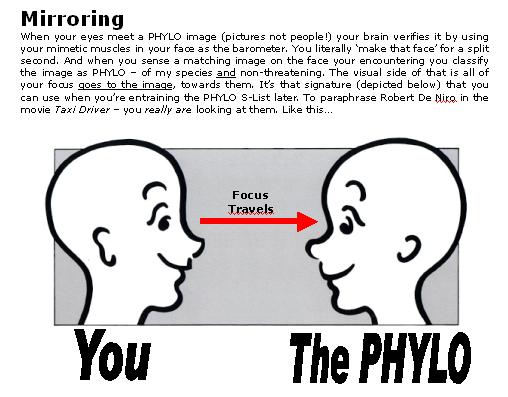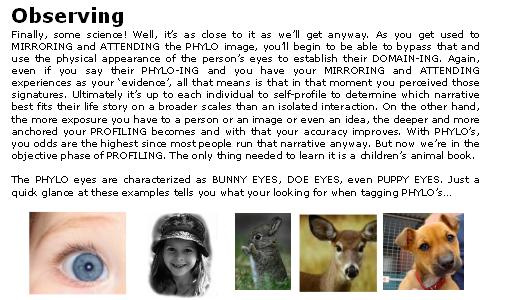The PHYLO Profile

This is the life story that is held by the lion's share of the population (68%). It features the elements of our original somatic orientation, which goes back to that mother-child bond from the 1st year of life. People with this PRIMARY DOMAIN are the more instinctive somas that seek that nurturing vibe from other people. Their attention focuses on deepening that species-based connection, which makes them very sensitive to changes in their social world. They draw their coherence from interpersonal sources and use a felt-sense awareness to access it. Their reference point for wholeness is usually their family, their close relationships and the security they get from having physical contact with those people. They learn best in steps so a linear, sequential approach is favored. They can also easily model or emulate others. Their optimal interpersonal distance is what's known as 'intimate space', which is from 0-1.5 feet from other people.
Are You A PHYLO?
Before you can understand or appreciate how deeply influential profiling others is, you need to first learn how to profile yourself. The golden rule in somatics is that it’s all a 1st person experience. In that sense, there’s no need to label people with these tools. What you’re learning to perceive is how their behavior reflects the perspective a particular domain expresses. To get there, you’ll need to learn the NARRATIVES of each domain first. By having even a basic idea of these, you can find out which one your organism internalized during the early stages of your social development. We’ll be repeating this step each time through the S-List, so get used to the drill…
The way you choose to describe yourself reveals your ‘closed identity”, which is 80% hard-wired by the time you’re 4 years old. This core is used to build the reality only you experience. When you ask yourself or any individual this question, their true colors are slowly revealed.
Read the following narrative three different ways...first to yourself as you see it here on the screen. Then print it out and read them in a mirror, as if you're trying to converse with your reflection. Then, if you're up to it, read it to someone else. All of these experiences are universal; self-talk, self-recognition, and self-disclosure. What you'll discover is if this narrative captures your life story or not. The words will flow easily if the biological level of your belief system buys what you're saying. You will have identified your PRIMARY DOMAIN. From there, the closed world you had can open.
The PHYLO Narrative…
I'm somebody who needs people around me all the time to be at my best. I value and nurture my relationships and enjoy many long-term friendships. I can easily bond with others and feel a profound sense of loss when that's not possible. I'm a team player and thrive in group settings where I can contribute. Some would say that I'm overly sensitive, but in fact I need to make some kind of contact in order to know I'm fully interacting. My feelings are my guiding force, and I'm very aware and respectful not to offend other people. I like being considered a good neighbor, relative and citizen. More than anything, I want a long, happy life.
So now that you have a general idea how a PHYLO acts, thinks and feels, let’s learn the practices you’ll use to notice how someone else expresses them. In that sense, what you’re really PROFILING is someone who is engaged in PHYLO-ING, since all we can do is perceive these signatures in action. What you’ll need to learn here is how to break that process down to simple and reliable practices that you can easily incorporate into your day.



Behavior Patterns
The PHYLO world operates on the principle of repetition. Here’s a simple checklist of their more prominent ways to navigate a conversation that you can use as ‘fast reads’ to learn where a person is drawing their clarity from in their interactions with you. The more PHYLO-ing you can spot, the easier it is to BOND with others in the moment and over time.
Friendly, Open Greeting
Receptive, Disarming Body Language
Intent Listening & Inquisitive, Subservient Voice Tones
Tactile-Oriented Word Choices {sticky situation, slippery people, rough road}
Polite, Affectionate Bodily Contact
Attention to Continuity, Past to Present, Upholding the Status Quo
Communication Habits
PHYLO’s are more interested in HOW you speak, than WHAT your saying. Keep these tips in mind and if you’re in a jam with them, these verbal ‘jug handles’ will help repair the bumps.
Initiates Small Talk
Absorbs One Idea At A Time, Don’t Overload Them!
Look For “The Nod Of Support” From Them When They’re Listening
Traditional Values Matter [family, religion, country, community, etc…]
Touch Their Left Shoulder To Reinforce New Ideas, Right Shoulder For Old Ones
Use Safe Words For Change: {Amend, Revise, Alter, Tweak}
PHYLO Spotting
Here’s a simple list of signature behaviors you can use to develop your PHYLO radar more
PHYLO WALK – short strides, choppy, plodding steps, subdued, understated arm swings
likes to hold hands when walking with family, friends, partners, often trails behind them too
PHYLO TALK – loves to gossip, sorts for drama, reactive in conversations
PHYLO TECH – prefers text chat, instant message, i-Phone, anything interactive
PHYLO WORLD – works to avoid worst case scenario, holds pessimistic view of the future
Here's some celebrity PHYLO's to get you started 'somaspotting'
For a complete introduction to somatic PROFILING, read our e-book